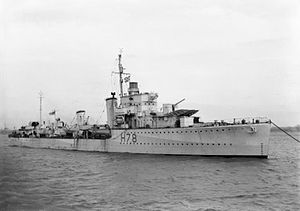Convoy SC 104
| Convoy SC 104 | |||||||
|---|---|---|---|---|---|---|---|
| Part of World War II | |||||||
 HMS Fame |
|||||||
|
|||||||
| Belligerents | |||||||
|
|
|
||||||
| Commanders and leaders | |||||||
| CinC:Admiral Karl Dönitz | Commodore: CAPT F H Taylor RN Escort: CDR R Heathcote |
||||||
| Strength | |||||||
| 8 U-Boats | 48 freighters 2 destroyers 4 corvettes |
||||||
| Casualties and losses | |||||||
| 2 U-boats sunk 2 U-boats damaged 50 dead |
8 freighters sunk 2 destroyers damaged 216 dead |
||||||
Convoy SC-104 was the 104th of the numbered series of World War II Slow Convoys of merchant ships from Sydney, Cape Breton Island to Liverpool. During October 1942, a U-Boat wolf pack sank eight ships from the convoy. The convoy escorts sank two of the attacking submarines.
As western Atlantic coastal convoys brought an end to the second happy time, Admiral Karl Dönitz the Befehlshaber der U-Boote (BdU) or commander in chief of U-Boats, shifted focus to the mid-Atlantic to avoid aircraft patrols. Although convoy routing was less predictable in the mid-ocean, Dönitz anticipated that the increased numbers of U-boats being produced would be able to effectively search for convoys with the advantage of intelligence gained through B-Dienst decryption of British Naval Cypher Number 3. However, only 20 percent of the 180 trans-Atlantic convoys sailing from the end of July 1942 until the end of April 1943 lost ships to U-boat attack.
Forty-seven ships departed New York City on 3 October 1942 and were met by Mid-Ocean Escort Force Group B-6 consisting of the E and F class destroyer Fame and V and W class destroyer Viscount, with the Norwegian-manned Flower class corvettes Potentilla, Eglantine, Montbretia, and Acanthus and the Convoy rescue ship Goathland.
Opposing this force was the U-boat Wolf pack Wotan comprising 8 boats: U-221, U-258, U-356, U-607, U-618, U-661, U-353, and U-254.
...
Wikipedia
